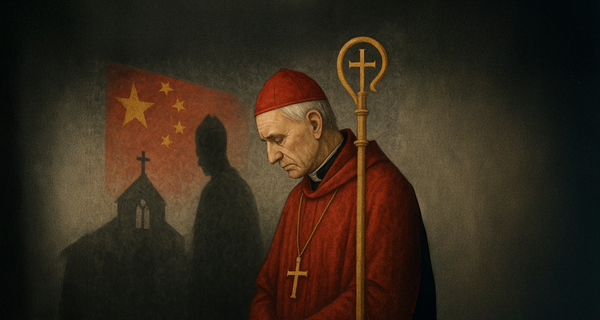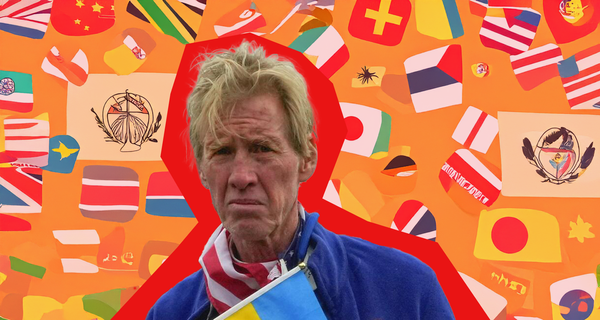Shadow Funds: Uncovering the Economics of Antifa
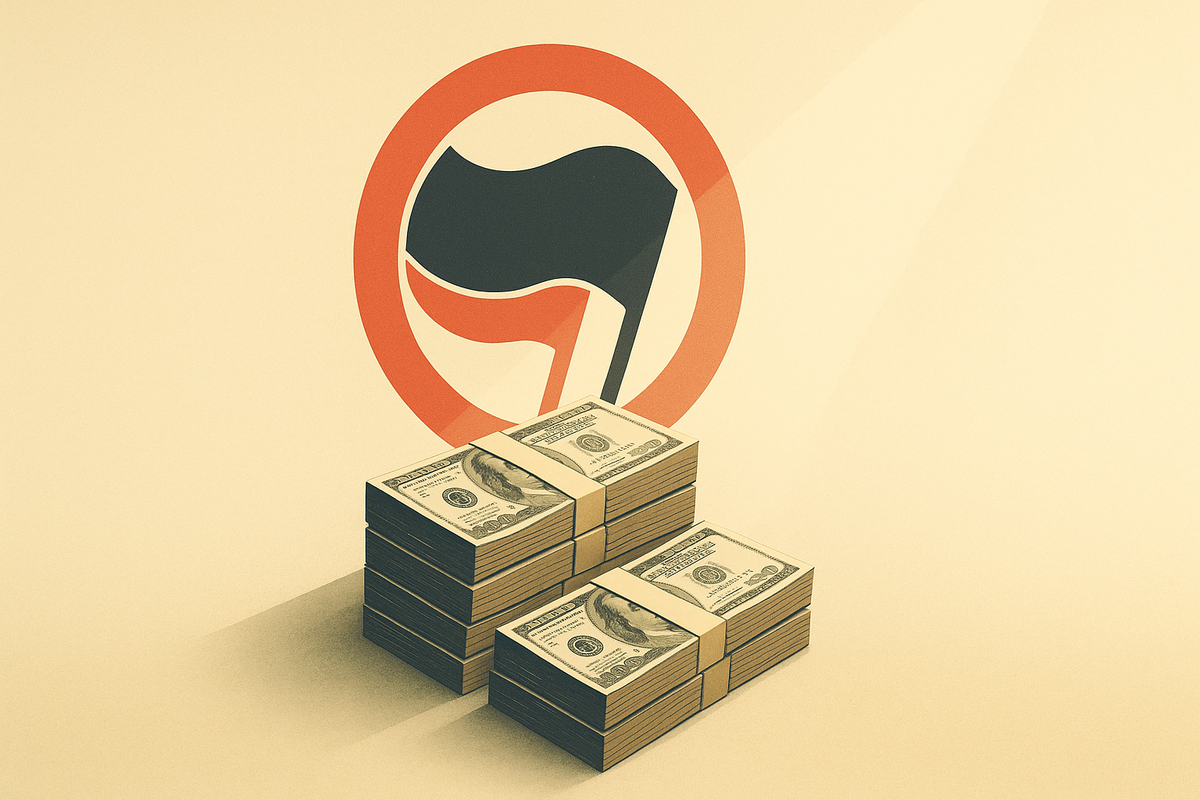
Updated October 9, 2025
An investigation into the funding networks, bail funds, and financial pipelines that create an economy of unrest.
On September 25, 2025, the White House issued a directive titled, “Enforcing the Death Penalty Laws in the District of Columbia to Deter and Punish the Most Heinous Crimes,” underscoring the administration’s willingness to wield maximal legal force in defense of order. Against that backdrop, protests and political violence are not peripheral, they are now part of a national security conversation.
Introduction: The Myth of Spontaneity
Antifa is often described as a loose collection of militants, anarchists, and street activists. Its defenders frame it as a movement without leaders or structure. What looks like spontaneous protest is frequently underpinned by coordinated logistics, legal defense funds, and financial pipelines that sustain the movement.
Behind the black bloc lies an economy of unrest: travel funds move activists between cities. Crowdfunding campaigns cover bail, medical bills, and equipment. Affiliated organizations provide logistical support under the banner of “mutual aid.” The effect is to transform sporadic street violence into repeatable operations.
This investigation tracks those shadow funds. It follows the flow of money that turns a fragmented ideology into coordinated action. By mapping the economics of Antifa, we move past slogans and imagery to the machinery that keeps the movement alive.
1. The Infrastructure of “Leaderless” Movements
While Antifa insists it has no hierarchy, movements cannot survive without structure. Coordinated networks exist to provide food, lodging, and legal representation. Activists are shuttled across state lines, plugged into host networks that greet them with pre-arranged resources. “leaderless resistance” is not the absence of organization, it is its camouflage.
Most fundraising organizations typically contribute to broader networks, meaning inter-fund transfers are not limited to one jurisdiction. This forms the basis of Antifa operating as an international organization and movement.
Name: Antifa International
Role: Transnational network that connects Antifa across borders.
Description: Antifa International provides a structural backbone to connect local cells, share logistical practices, pool resources, and facilitate cross-border action. In 2015 the International Anti-Fascist Defence Fund was launched (see below) to provide material support to Antifa worldwide.
Name: International Anti-Fascist Defence Fund
Role: Acts as a funding arm for far-left militants and delivers material support into the U.S.
Description:According to its own disclosures and fundraising pages, it has donated over $250,000USD to more than 800 anti-fascists across 26 different countries. Over the last twelve months, the organization has intervened nine times to assist 52 anti-fascists in Finland, France, Germany, the UK, and the US.
In 2023, the International Anti-Fascist Defence Fund provided bail support to the militant Elm Fork John Brown Gun Club, the same group linked to the ambush on an ICE facility in Alvarado, Texas, that left an officer wounded and triggered an FBI manhunt for Antifa-affiliated suspect Benjamin Song.
Name: Portland, Oregon
Role: Hub of Antifa activity and taxpayer-funded settlements to militants
Description: Portland, Oregon, has effectively funneled over $3 million in taxpayer dollars to Antifa-linked individuals through lawsuit settlements related to police interactions during the 2020 riots. These payouts stem from claims of excessive force against protesters and rioters, including known Antifa extremists who participated in violent unrest against law enforcement and federal property.
For instance, the city approved a $400,000 settlement to Dustin Brandon Ferreira (alias "Wheels"), an Antifa associate arrested during a 2020 riot, and $375,000 to Meghan Lea Opbroek, a far-left agitator injured at an Antifa-led attempt to burn down a police precinct. Overall, Portland has disbursed just over $3 million since 2020 for such claims, often to avoid trial risks, as reported by the city's attorney's office and local outlets. This pattern is criticized as rewarding violence, with settlements going to those involved in assaults, arson attempts, and clashes with police (Washington Examiner, 2025).
2. Crowdfunding as a War Chest
Platforms like GoFundMe, Patreon, and lesser-known anarchist-hosted sites have become lifelines. Campaigns raise money for:
- Bail and legal fees for arrested protesters.
- Medical expenses for injuries sustained during riots.
- Protective gear like helmets, goggles, and shields.
- Travel stipends to send “comrades” where confrontations are planned.
In effect, crowdfunding transforms local skirmishes into a mobile insurgency. Money raised in Portland can bankroll a protest in Washington, D.C. A riot in Atlanta can be funded by donors in Germany.
Name: Minnesota Freedom Fund (MFF)
Role: Per charter, they are a state-based bail fund that disburses bail and immigration bonds on behalf of protest-related arrestees, criminal defendants, and immigration detainees held in removal proceedings.
Description: Antifa rioter Thomas Moseley, 29, of Blaine, Minnesota was arrested multiple times during 2020 protests and riots, including for vandalism, weapons possession, and property damage. The Minnesota Freedom Fund posted bail for him on multiple occasions: once a $5,000 bail related to a riot on October 15, 2020, and another time a $60,000 bail connected to a December 31, 2020 BLM/Antifa riot. Moseley later pled guilty to federal weapons charges.
Although MFF is legally chartered to posts cash bail and immigration bonds within Minnesota, they received a large influx of funds and redistributed donations to other bail funds nationwide through inter-fund transfers.
The MMF fund was promoted by Kamala Harris during the riots.
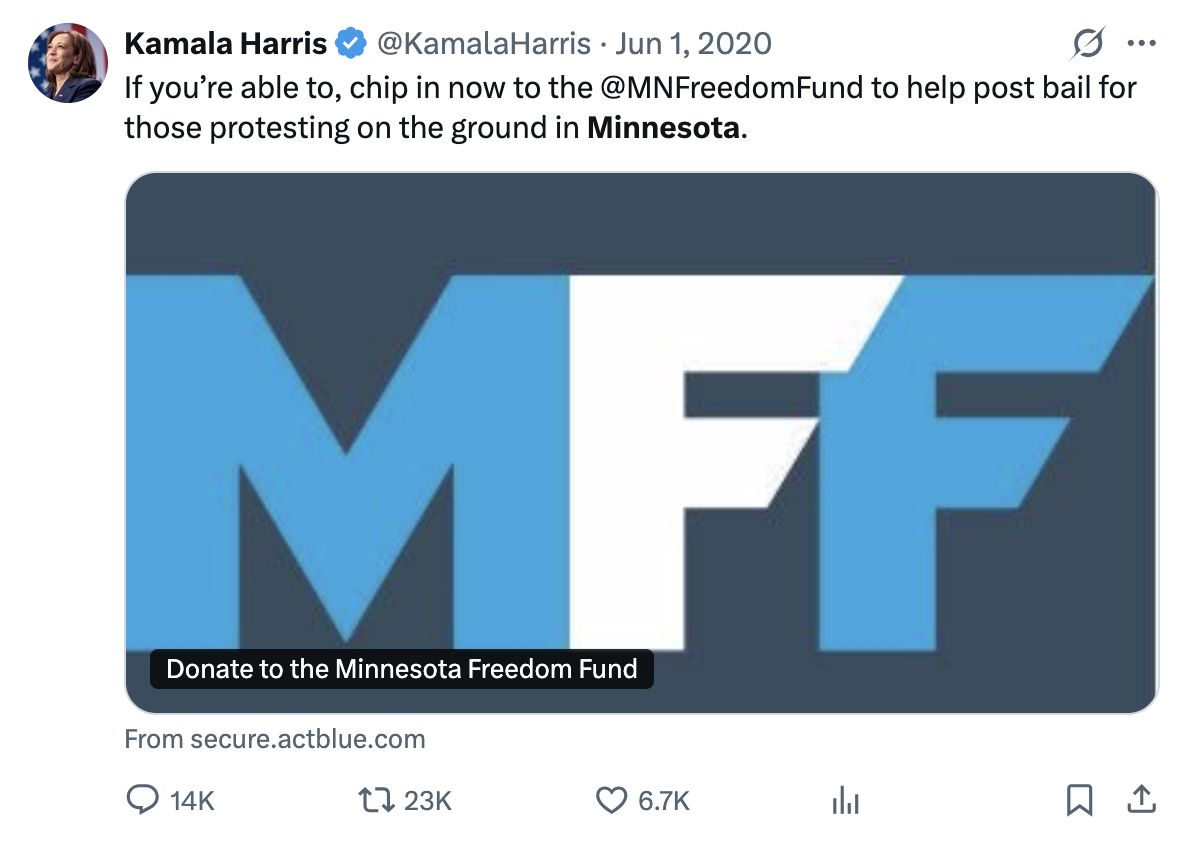
Name: Arabella Advisors
Role: For-profit consulting and philanthropic-management firm that operates administrative, payroll, and advisory services for major fiscal sponsors, most notably the Sixteen Thirty Fund, a dark money super-PAC and the New Venture Fund. Arabella connects these groups, and is named in these funds’ IRS Form-990 Schedule O filings as the provider of administrative services and the recipient of management fees.
Description: Sixteen Thirty Fund and New Venture Fund list payments to Arabella for management, payroll, consulting, and reimbursable expenses in their Schedule O filings. The funds’ Schedule I tables list hundreds of downstream grantees, including national intermediaries and fiscal hosts that promoted or fiscally hosted local bail, legal-defense, and mutual-aid funds supporting protest infrastructure. Some of those local initiatives were active in demonstrations that later escalated to clashes or violent incidents in Atlanta and Portland.
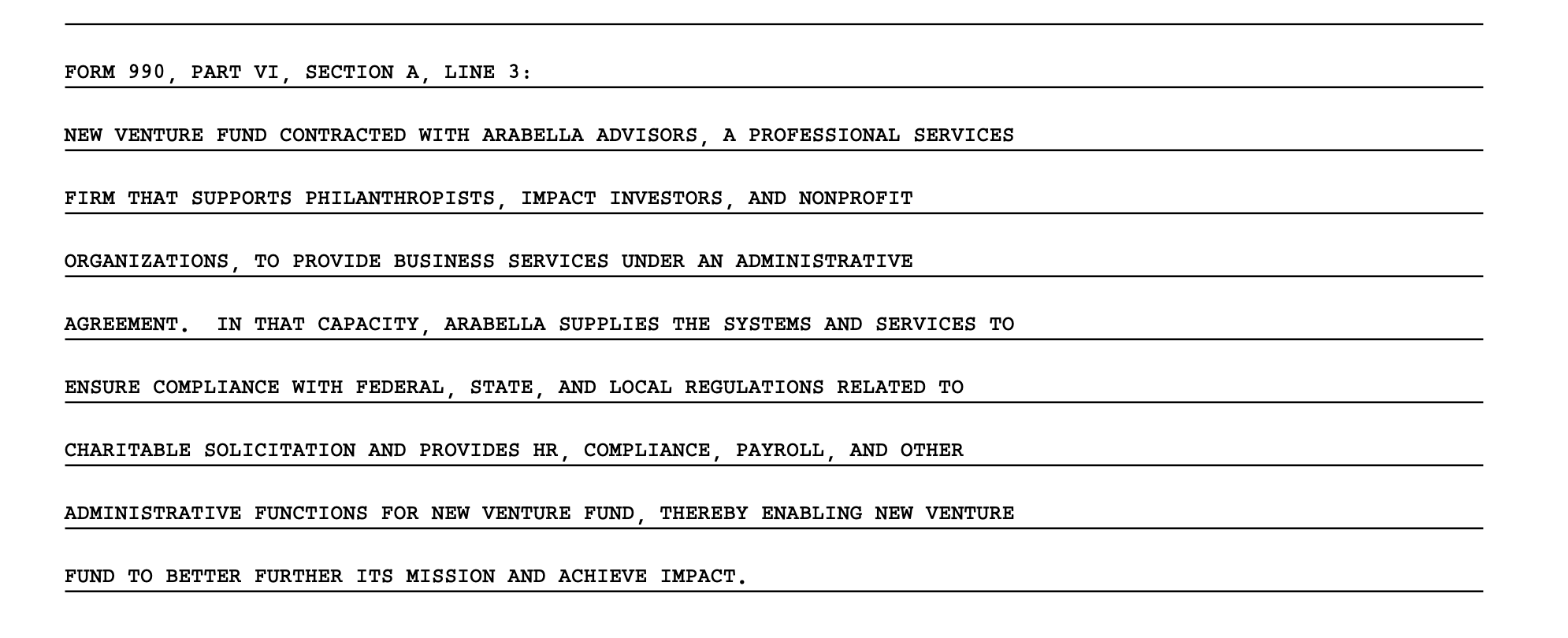
3. Mutual Aid or Movement Logistics?
Groups that present themselves as “mutual aid collectives” often function as logistical arms. Kitchens provide meals, volunteer medics treat injuries, and carpools shuttle protesters in and out of hot zones. On the surface these services appear humanitarian, but in practice they form the infrastructure that sustains conflict.
Funding flows primarily through decentralized peer-to-peer channels such as Venmo and Cash App. These mechanisms are common across Antifa-aligned mutual aid networks and complicate external auditing. The function is operational: to reduce time-to-release for arrested individuals and return them to the field, sustaining repeat protest activity.
Name: Mutual Aid Houston (MAH)
Role: Describes itself as a BIPOC-led abolitionist collective. Organizes direct assistance, jail-support for arrestees, resource consolidation, and protest support services that facilitate activist persistence.
Description: Mutual Aid Houston is listed in a Google document curated by MOVE Texas, another group with abolitionist leanings, under the category "Autonomous Mutual Aid Groups". The same directory was amplified by It's Going Down, a media platform closely aligned with Antifa organizing.
In joint listings, MAH operates within overlapping networks like the Elm Fork John Brown Gun Club in nearby Denton. MAH’s involvement in jail and protest support contributes to the logistical infrastructure that enables repeated mobilization.
According to Senior Analyst for DHS & Counterterrorism, Kyle Shideler, among the groups MAH says it works with is, "Food Not Bombs", in 2006 it was reported that Food Not Bombs was on the FBI terrorism watch list (Center for Security Policy, 2021).
Name: Tides Network (Tides Foundation and Tides Center)
Role: Fiscal sponsorship and grant-making hub for left-wing causes, providing pass-through funding to radical groups that enable Antifa-style protests and mutual aid.
Description: The Tides Foundation and Tides Center have distributed millions to politicized NGOs engaged in anti-racist and anti-Israel activism, many of which intersect with Antifa tactics during campus occupations and street actions. Notably, Tides received over $27 million in USAID grants, which were rerouted to support extremist networks, including those funding pro-Palestinian protests with Antifa participation. The organization has also faced scrutiny for its role in a surge of fundraising that bolstered abolitionist and protest bail funds used by Antifa militants in events like the 2020 riots, as detailed in White House funding revelations (The Daily Signal, 2025).
4. Legal Defense Networks
Perhaps the most resilient funding streams are those dedicated to legal defense. Organizations style themselves as civil liberties defenders, but their function is to normalize repeat arrests. Bail funds and legal aid ensure activists can cycle back onto the streets quickly, keeping pressure on opponents and exhausting law enforcement resources.
Name: National Lawyers Guild (NLG)
Role: A progressive legal organization that coordinates legal defense for protest movements, provides “mass defense” support, deploys legal observers, operates hotlines during demonstrations, offers “know your rights” training, and connects rioters to legal resources.
Description: The Mass Defense Program is a central component of the NLG’s activist legal arm. It mobilizes lawyers, law students, legal workers, and organizers to provide legal support for protesters, before, during, and after actions.
The NLG also publishes “Know Your Rights / Protester Guides” in multiple languages and distributes them during mobilizations. The Guild frequently works in coalition with civil liberties, labor, anti-racist/Antifa, abolitionist, and international legal advocacy organizations.
Name: Torch Network
Role: Decentralized network of antifa affinity groups across the U.S. that coordinate protest action, information sharing, mutual support, and resource pooling.
Description: The Torch Network is often understood as the successor to the anti-racist network Anti-Racist Action (ARA), which formally dissolved in 2013. Some ARA chapters realigned under the Torch name.
The Torch site lists multiple autonomous local chapters (e.g. Rose City Antifa, Atlanta Antifascists, Central Texas ARA, Front Range Antifa, etc.). Membership into the network involves being vouched for by existing chapters.
Torch Network functions as a coordinating body of the Antifascist Defence Fund.
5. International Pipelines
Funding is not purely domestic. International solidarity networks send money into the U.S., just as U.S.-based activists channel funds abroad. From anarchist collectives in Europe to diaspora groups aligned with far-left causes, the flow of resources blurs borders. Antifa is not merely an American problem—it is plugged into a transnational economy of unrest.
Name: Neville Roy Singham
Role: Funder of radical leftist networks and pro-CCP propaganda.
Description: Neville Roy Singham, a Shanghai-based U.S. millionaire, indirectly supports Antifa through funding U.S. nonprofits like the Justice and Education Fund and People’s Forum, which channel money to radical groups such as the Party for Socialism and Liberation (PSL) and ANSWER Coalition. These organizations share Antifa’s anti-capitalist, anti-imperialist ideology and collaborate in protests, including pro-Hamas rallies and the 2024 Columbia University takeover, where Antifa militants were active. Singham’s financial network, tied to the Chinese Communist Party, include sharing office space with the pro-Beijing Maku Group and co-producing content for Shanghai’s propaganda department. The U.S. Senate Committee on the Judiciary has documented an investigation into these ties.
The PSL attended an international Antifa festival in Caracas in 2024 (Washington Examiner, 2025).
Name: Open Society Foundations
Role: Global philanthropy network funding progressive and human rights initiatives, with allegations of indirect support for Antifa-linked protest activities.
Description: Founded by George Soros, the Open Society Foundations have reportedly funneled over $80 million since 2016 into left-wing extremist groups, including those with direct ties to Antifa cells and networks involved in violent protests. This funding has supported organizations like the Stop Cop City and Defend the Atlanta Forest coalition, which has been explicitly linked to Antifa-associated extremism and sabotage actions against law enforcement. The network's contributions are part of a broader "Riot Inc." ecosystem accused of enabling coordinated unrest across U.S. cities (Capital Research Center, 2025).
Name: Hansjörg Wyss Foundation
Role: Philanthropic entity led by Swiss billionaire Hansjörg Wyss, channeling foreign funds into U.S. progressive networks that sustain Antifa-aligned protest ecosystems.
Description: Wyss has contributed significantly to the "Riot Inc." framework, with donations exceeding tens of millions funneled through Arabella Advisors to organizations supporting Antifa-linked protest networks and violence. As a non-U.S. citizen, his funding has been highlighted in White House disclosures for enabling domestic unrest, including grants to groups involved in anti-fascist actions and radical mobilization. This includes backing for environmental justice initiatives that overlap with Antifa's anti-capitalist disruptions, such as pipeline protests and urban riots.
6. The Machinery of Repeatability
Every movement requires energy, and for Antifa, that energy is cash. Without money, arrests would stick, travel would stall, and activists would remain isolated. With money, the cycle repeats: planning, mobilization, confrontation, and replenishment.
Following the Money
Antifa thrives not because it is popular, but because it is funded. Its shadow economy of crowdfunding, mutual aid networks, and legal pipelines converts ideology into action. To understand Antifa is to follow the money: beyond the slogans, beyond the black masks, lies an infrastructure that keeps the movement alive.
References:
Center for Security Policy. (2021, March). Risks abound as Antifa-aligned “mutual aid” groups respond [PDF]. Center for Security Policy. https://centerforsecuritypolicy.org/wp-content/uploads/2021/03/Antifa_Aligned_Mutual_Aid_Groups_Respond_PDFV2.pdf
Network Contagion Research Institute. (n.d.). CCP influence and radical ideologies. https://networkcontagion.us/reports/ccp-influence-and-radical-ideologies/
Mauro, R. (2025). Exclusive: Soros’ Open Society gave terrorist and pro-terror groups over $80 million (Report). Capital Research Center. https://capitalresearch.org/app/uploads/Report.pdf



